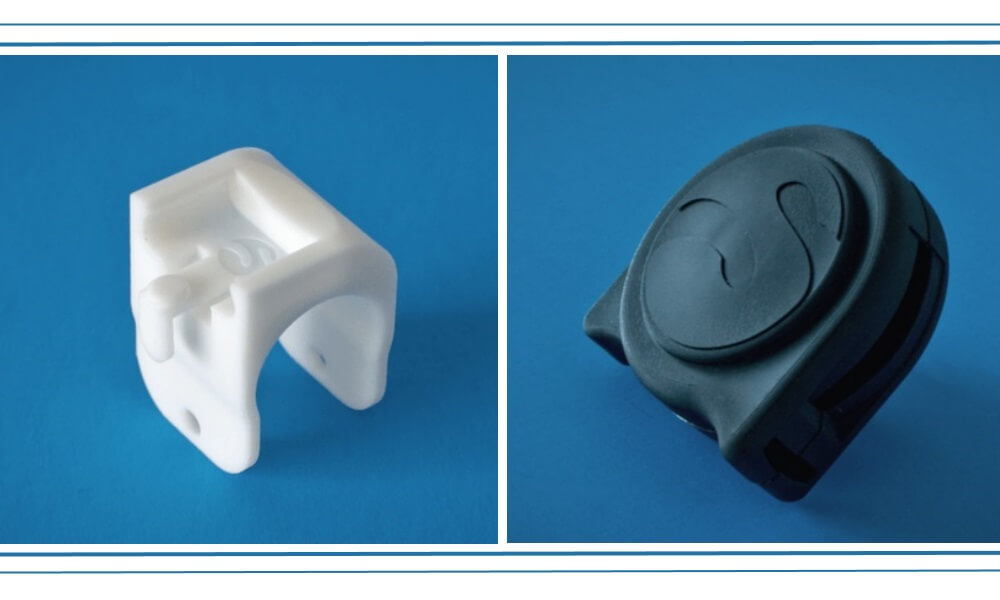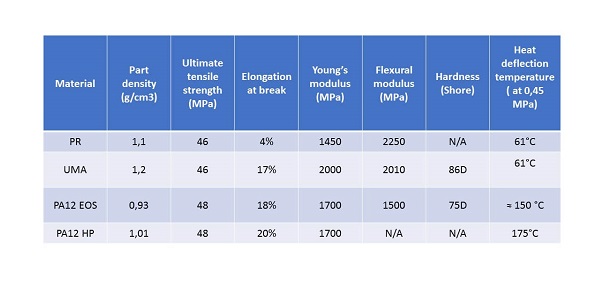New 3D printing material available: Discover the Urethane Methacrylate resin
Posted By Lucie Gaget on Jul 18, 2018 | 0 comments
At Sculpteo, we always want to offer the best 3D printing service possible to our customers. That is why we decided to expand our 3D printing materials offer by adding a brand new resin: the Urethane Methacrylate resin, or UMA 90. This UMA resin is another resin printed using the CLIP (DLS) technology, or Continuous Liquid Interface Production, developed by Carbon. To describe it in a few words, UMA is one of the strongest resins that we are now offering. It is an interesting material as a lot of its mechanical properties are similar to one of the most traditional plastics used in the 3D printing industry: Nylon PA12.
We are going to see in this blog post what this new Urethane Methacrylate material is and what its advantages are. We are also going to come back to the CLIP technology and see what the main aspects to take into account are while starting a 3D printing project with this great technology. Follow the guide and discover this new material!
Urethane Methacrylate: Advantages and particularities of this new resin material
What is the UMA material?
Our Urethane Methacrylate (UMA 90) resin material creates 3D printed objects from photosensitive polymer liquid resin. This liquid resin is then solidified by UV light layer by layer to create rigid and highly detailed prints. It is the CLIP (DLS) technology.
UMA 90 is a very stiff and strong 3D printing material. The 3D printed parts created with this new resin material developed by Carbon are comparable to injection molded plastics, which makes it a really interesting material to develop prototypes but also resistant finished products. One of the main advantages of this material is its smooth surface. Indeed, objects 3D printed using this resin are naturally smooth and you don’t need post-treatments similar to the ones you need with Nylon PA12 parts!
Similarities with Nylon PA12
As a reminder, our Nylon PA12 is a thermoplastic polymer. It is a macromolecule (monomer of 12 carbons) linked to the other macromolecules by intermolecular bonding that disappears when the material is heated and reappear when it’s cooled. Nylon 12 is appreciated in all industrial sectors. Indeed, it is a material with good mechanical properties, which can be used for a lot of different applications. UMA is a resin material using the CLIP (DLS) process to be 3D printed, and the Nylon PA12 is a plastic material using the Selective Laser Sintering to be 3D printed. But these two materials have a lot in common!
UMA resin is a polymer photosensitive resin. Polymerisation takes place on the luminous pictures sent by the printer. As we can see on the following table, the Urethane Methacrylate resin has mechanical characteristics that are really close to Nylon PA12’s characteristics. This resin is a really polyvalent material.
In opposition to this plastic material, this resin is not as heat resistant and can be deformed if exposed to important heat. Near hot spots, our Nylon PA12 is still a better choice than the resin.
Urethane Methacrylate: Better mechanical properties
The real difference between these 2 materials comes from the manufacturing process. The resin gets all the advantages of the CLIP (DLS) technology. This technology allows producing a small number of parts in a few hours, with a really good surface finish, even for really complex geometries. Moreover, UMA 90 is now one of our strongest materials available.
Nylon parts must be polished to get a similar surface finish. The polished effect that we can see for this material is a reduction of the roughness. Moreover, parts 3D printed in resin will also get a longer lifetime than 3D printed plastic parts in Nylon PA12. Finally, this resin allows to print mass-colored parts (black) while the Nylon PA12 parts must be dyed. This new Carbon resin provides polished parts without the disadvantages of the mechanical polishing: slow process, break risks and outside surfaces limitations.
Why should you choose this Urethane Methacrylate material?
It is important to choose the right material to manufacture your project. A lot of these objects are doable using Nylon PA12, but you will definitely have a better result using this new Carbon material. The objects printed with this resin will be stronger and even more detailed.
Urethane Methacrylate is particularly great to prototype impellers and hollowed parts for fluid circuits. As this material doesn’t require a polishing process, it will reduce the costs and allow you to print a part that will directly have a good surface and allow you to make some precise tests with your prototypes.
The smooth surface of this material will also allow you to produce functional 3D printed parts with a longer lifetime. For example, this resin can be perfect for you if your need is to manufacture parts such as a functional skid or sliding rings.
Moreover, the Urethane Methacrylate resin creates parts with a really great look. Indeed, it is really good for aesthetical parts, with mechanical functions or not. Miniatures, cases, mechanical parts which can be seen: all of these projects can be printed with this UMA 90 and you will have a really good result.
Information to keep in mind while using the CLIP technology
Here are some points that you should know before using the Urethane Methacrylate resin for your 3D printing project. Knowing the requirements and rules of this 3D printing technology will help you to make the most of it, and to save time and money. If you are not used to printing resin material, you may not know about this CLIP technology. Here are the main aspects that you have to keep in mind before getting started with your 3D printing project:
- There is a limit of accuracy below which details won’t be precise. For the CLIP technology, the accuracy comes from the resolution of the pictures used to polymerize the resin and some optical diffraction effects inside the printer. For the Urethane Methacrylate resin, the limit is 400µm in the Z axis and 100µm for the other axis.
- The minimal thickness must be respected. Very thin walls can be miss-printed, or break during the printing process or during manipulations. That is why we advise you to read carefully the design guidelines on the Urethane Methacrylate material page before designing your 3D file on your 3D modeling software.
- While using the CLIP technology, stereolithography or FDM, some parts might need supports to be produced. The different reasons are:
- Unlike the FDM technology, the platform is located above the CLIP part and plunge in resin material during the manufacturing process. The resin material is slimy and creates suction force each time the platform goes back up. It is quite important to have enough contact surface between the part and the platform. If there is not enough contact the 3D printing technician can choose to add some supports.
- In the case of important overhang features (more than 1,5mm) with an angle higher than 45° from the vertical, the part will be deformed without supports.
- For the parts with complex geometries, sometimes the geometrical center is not in the middle. In this case, the platform can take the part down, that is why supports are necessary.
- Last concern point is from the resin flow. There is a risk that resin can be trapped during the printing process. That will put pressures against some walls which can be deformed or which could possibly break
- As shown on this figure, during the printing process, resin’s viscosity may prevent resin to evacuate correctly. It is important to let the air circulate in the volume. There are actually two possibilities to do so. During the conception of your model, you have to create canals to allow the air circulation, as we can see in the figure. The other solution is that the technician can put supports on the part.
Here is one of our last recommendations: while creating your model, you need to think about which orientation you want to choose to produce the part. All the important bindings, supports, unvented volumes, depending on the orientation.
This new Urethane Methacrylate developed by Carbon combines advantages and specificities of Nylon PA12 and of the CLIP technology. As you can see, it is quite interesting and offering new possibilities. Are you ready to 3D print your next project using this amazing material? Give it a try, and upload your 3D model right now on our online 3D printing service.
If you don’t want to miss one of our announcements and our new 3D printing materials, we advise you to subscribe to our newsletter!


 Connect with Google
Connect with Google Connect with Facebook
Connect with Facebook


